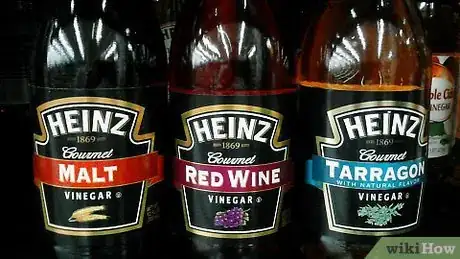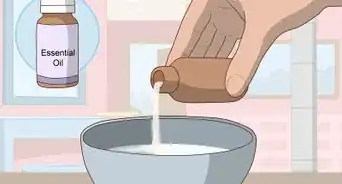This article was co-authored by wikiHow Staff. Our trained team of editors and researchers validate articles for accuracy and comprehensiveness. wikiHow's Content Management Team carefully monitors the work from our editorial staff to ensure that each article is backed by trusted research and meets our high quality standards.
There are 15 references cited in this article, which can be found at the bottom of the page.
The wikiHow Video Team also followed the article's instructions and verified that they work.
This article has been viewed 16,318 times.
Learn more...
Recent studies have shown that drinking vinegar may offer a range of potential health benefits, from accelerated weight loss[1] to improved diabetes symptoms [2] . But what’s the best way to consume enough of the tangy tonic to reap the rewards? Easy—just mix 1–2 tablespoons (15–30 mL) in with a small amount of water and gulp it down. If you like, you can also smuggle your daily dose of vinegar into another one of your favorite beverages, such as a nourishing smoothie or even a fancy cocktail.
Steps
Downing Vinegar with Water
-
1Pick up a bottle of malt vinegar at your local supermarket. You’ll find malt vinegar on the same shelf as other popular varieties of vinegar. It’s typically a deep amber or reddish-brown color, which comes from fermenting the malted grains of barley—in other words, beer.[3]
- Make sure the vinegar you buy is clearly labelled with the word “malt.” Other common types of vinegar, like white and balsamic, don’t qualify as malted, and may not offer the same nutritional perks.
-
2Portion out the daily recommended dose of 1–2 tablespoons (15–30 mL). Use a liquid measuring spoon or a small measuring cup to ensure that you’re getting just the right amount. If you’re not sure exactly how much to use, start with 1 tablespoon (15 mL) and gradually increase the quantity over time as you grow accustomed to the taste.[4]
- In a 2009 study designed to observe the effects of vinegar as a dietary supplement, 2 tablespoons (30 mL) was the maximum effective dosage administered to test subjects.
Warning: Be careful about drinking too much vinegar at one time. Doing so could give you an upset stomach or have other undesirable consequences.[5]
Advertisement -
3Mix the vinegar with 2–3 fluid ounces (59–89 mL) of water in a small glass. Not only will cutting the vinegar with water improve the flavor of the drink (or at least keep it from being quite as objectionable), it will also reduce its overall acidity. This is an important consideration if health is your primary concern.[6]
- For a more pleasant drinking experience, you can also add a squirt of honey, which will offset the acidity of the vinegar a bit.
- Like other varieties of vinegar, malt vinegar contains a high concentration of acetic acid, which can cause esophageal irritation, deterioration of tooth enamel, and other harmful effects if consumed by itself.[7]
-
4Gulp the mixture down. All that’s left to do now is take your diluted vinegar concoction and toast to your health. You may be surprised by how easily it goes down, especially knowing all of the good things it could be doing for your body. You may even find yourself looking forward to your next shot![8]
- You may want to toss your beverage down quickly if you’re not a fan of the way vinegar tastes.
Incorporating Vinegar into Other Beverages
-
1Add a little malt vinegar to a drink that’s already lightly sweetened. Things like bottled tea, fruit juice, and lemonade can make good vehicles for vinegar because of their high sugar content. Fill a glass with your beverage of choice, then stir in 1–2 tablespoons (15–30 mL) and throw it down the hatch.[9]
- Using iced coffee or cola as the base for your concoction could also make it more palatable.
-
2Blend some vinegar into a nutritious smoothie. Start by tossing a few fruits, vegetables, and other healthy offerings into the blender. Then, measure out your vinegar and sprinkle it over the rest of your ingredients before blending it all to a smooth consistency. When it’s all said and done, the vinegar will be so well-incorporated that you probably won’t even be able to tell that it’s there. Bottoms up![10]
- Bananas, apples, peaches, mango, pineapple, broccoli, kale, spinach, and carrots are all delicious and nutritious options, but you can pretty much go wild here. It’s your smoothie, so feel free to customize it however you please![11]
- Keep the big picture in mind while selecting your add-ins. Fruits that are high in sugar are safe choices, as are most vegetables. However, things like berries and citrus may prove to be a bit much when combined with the bright acidic notes of the vinegar.
-
3Mix up a vinegar-based cocktail. Just bring your ingredients together in a large glass or shaker and dump in the vinegar right before you start mixing. Most drink recipes call for somewhere between 1⁄4 fluid ounce (7.4 mL) and 1⁄2 fluid ounce (15 mL) of vinegar, but you can use more or less to suit your tastes, if you like.[12]
- Garnish your completed cocktail with one or more sweet items to offset the acidic tang. Some good possible choices include a rim of sugar, some fresh fruit slices, a couple mouth-puckering cherries, or a sprig of mint.
- There are a number of mixed drinks that rely on vinegar to impart a sharp, zesty undertone. The most well-known examples are shrubs and gimlets, but various vinegars are also catching on as that all-important acidic component in traditional cocktails like Manhattans and Bloody Marys.[13]
Tip: Don’t hesitate to experiment with malt vinegar in any of your other favorite cocktails if you think it might complement the flavors at play.
-
4Brew a comforting cup of vinegar “tea.” Bring a kettle of water to a low boil on the stovetop. While your water is heating up, grab your favorite mug and add 1–2 tablespoons (15–30 mL) of malt vinegar, 2 tablespoons (30 mL) of fresh-squeezed lemon juice, 1 tablespoon (15 mL) of honey and a pinch of cinnamon. Once your water is ready, pour in 10–12 fluid ounces (300–350 mL), stir the mixture well, and let it cool to a safe temperature before enjoying.[14]
- Go as heavy on the honey as you need to mask the taste of the vinegar.
- This type of drink can also make a nice hot toddy when you’re feeling under the weather.
Warnings
- While holistic proponents make all kinds of bold claims about the healing powers of vinegar, most of them have yet to be scientifically verified.⧼thumbs_response⧽
- Try not to exceed the maximum recommended daily dose of around 2 tablespoons (30 mL). Too much vinegar could overpower your drink or put you at risk of stomach ache, tooth decay, or other cause by high levels of acidity.⧼thumbs_response⧽
References
- ↑ https://www.health.harvard.edu/blog/apple-cider-vinegar-diet-does-it-really-work-2018042513703
- ↑ https://care.diabetesjournals.org/content/27/1/281
- ↑ https://www.finecooking.com/ingredient/malt-vinegar
- ↑ https://healthfully.com/280239-malt-vinegar-diet.html
- ↑ https://www.webmd.com/diet/apple-cider-vinegar-and-your-health#1
- ↑ https://www.making-vinegar.com/tools/calculations/diluting-vinegar/
- ↑ https://www.consumerreports.org/healthy-eating/is-vinegar-good-for-you/
- ↑ https://www.bbc.com/future/article/20180924-can-vinegar-cure-illness-here-are-the-facts
- ↑ https://awhiskandtwowands.com/orange-vinegar-drink/
- ↑ https://www.youtube.com/watch?v=9_rL7GrgSms&feature=youtu.be&t=170
- ↑ http://www.eatingwell.com/article/277310/healthy-smoothies-best-smoothie-ingredients-10-to-ditch/
- ↑ https://www.theguardian.com/lifeandstyle/2008/dec/09/how-to-make-cocktails
- ↑ https://www.nytimes.com/2011/10/12/dining/vinegar-cocktails-are-making-the-rounds.html
- ↑ https://www.allrecipes.com/recipe/244510/apple-cider-vinegar-tea/
- ↑ https://onlinelibrary.wiley.com/doi/full/10.1111/1750-3841.12434




























































